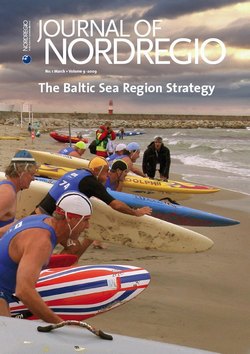 Looking at the Action Plan, four thematic pillars describe the strategy in detail, which is, namely, to make the Baltic Sea Region:
Looking at the Action Plan, four thematic pillars describe the strategy in detail, which is, namely, to make the Baltic Sea Region:
- An environmentally sustainable place (main issues concerning the marine environment),
- A prosperous place (main issues concerning prosperity),
- An accessible and attractive place (main issues concerning transport and energy), and
- A safe and secure place (main issues concerning safety and security).
In accordance with the region's future development the Action Plan may be revised but for now it comprises 15 priority areas corresponding to the four thematic pillars mentioned above. Each priority area is coordinated by 1-2 Member States and transformed into detailed actions. These can be either strategic (addressing issues that are especially important to specific regions, citizens and enterprises) or cooperative (focussing on issues that might enhance cooperation between Member States and stakeholders). 80 examples of so-called Flagship projects are, additionally, listed by naming a lead partner and a deadline for finalisation.
The Commission as well as all of the stakeholders identified, i.e. other Member States, regional and local authorities, Inter-Governmental and Non-Governmental bodies should be involved in the implementation process.
According to the Action Plan the Nordic Council of Ministers for instance leads a Flagship project that is going to "Create a Baltic Sea Fund for Innovation and Research" under the priority area that focuses on the potential in research and innovation. Other Flagship projects concentrate on themes such as e.g. water quality, biodiversity, climate change, entrepreneurship, research and innovation, energy, accessibility, transport, attractiveness, and safety and security with a number of these having already been implemented.
Last but not least, horizontal actions conclude the Action Plan. Here, the development of e.g. integrated maritime governance structures as well as the use of research as a basis for policy decisions and of Maritime and Land-based Spatial Planning are cross-cutting themes identified in order to promote Territorial Cohesion with both land and maritime dimensions.
The financing of actions and projects does not come from the strategy itself. However, the European Regional Development Fund (ERDF) as well as other EU funding mechanisms will back their implementation in the Baltic Sea Region financially for the period 2007-2013.
Having said this, the strategy is an integrated framework and thus relies rather more on the engagement of governments and citizens than on regulations. Moreover, the strategy's overall aim is to address current and future challenges as well as emerging opportunities by enhancing the coordination of joint actions in the Baltic Sea Region. Thus, the strategy tackles problems and strengthens development potentials on a "macro-regional" level - among Member States, regions, the EU, pan-Baltic organisations, financing institutions and non-governmental bodies.
Discussion and cooperation will also be initiated with external partners, especially Russia. In so doing, the European Council hopes to highlight the Northern Dimension as an already existing common policy of the EU, Russia, Norway and Iceland as well as of other international bodies and their decision-making mechanisms, e.g. the Council of the Baltic Sea States (CBSS), the Nordic Council of Ministers or the Helsinki Commission (HELCOM).
The EU Baltic Sea Strategy is one of the main priorities of the 2009 Swedish EU Presidency and its proposal is now being discussed by the European Parliament and the Member States. When the document is finally agreed by the end of the year it will surely contribute to the regional implementation of the EUs Integrated Maritime Policy.
References:
Action Plan - Working document accompanying the Communication concerning the European Union Strategy for the Baltic Sea Region - SEC(2009) 712 - 10 June 2009
http://ec.europa.eu/regional_policy/cooperation/baltic/index_en.htm